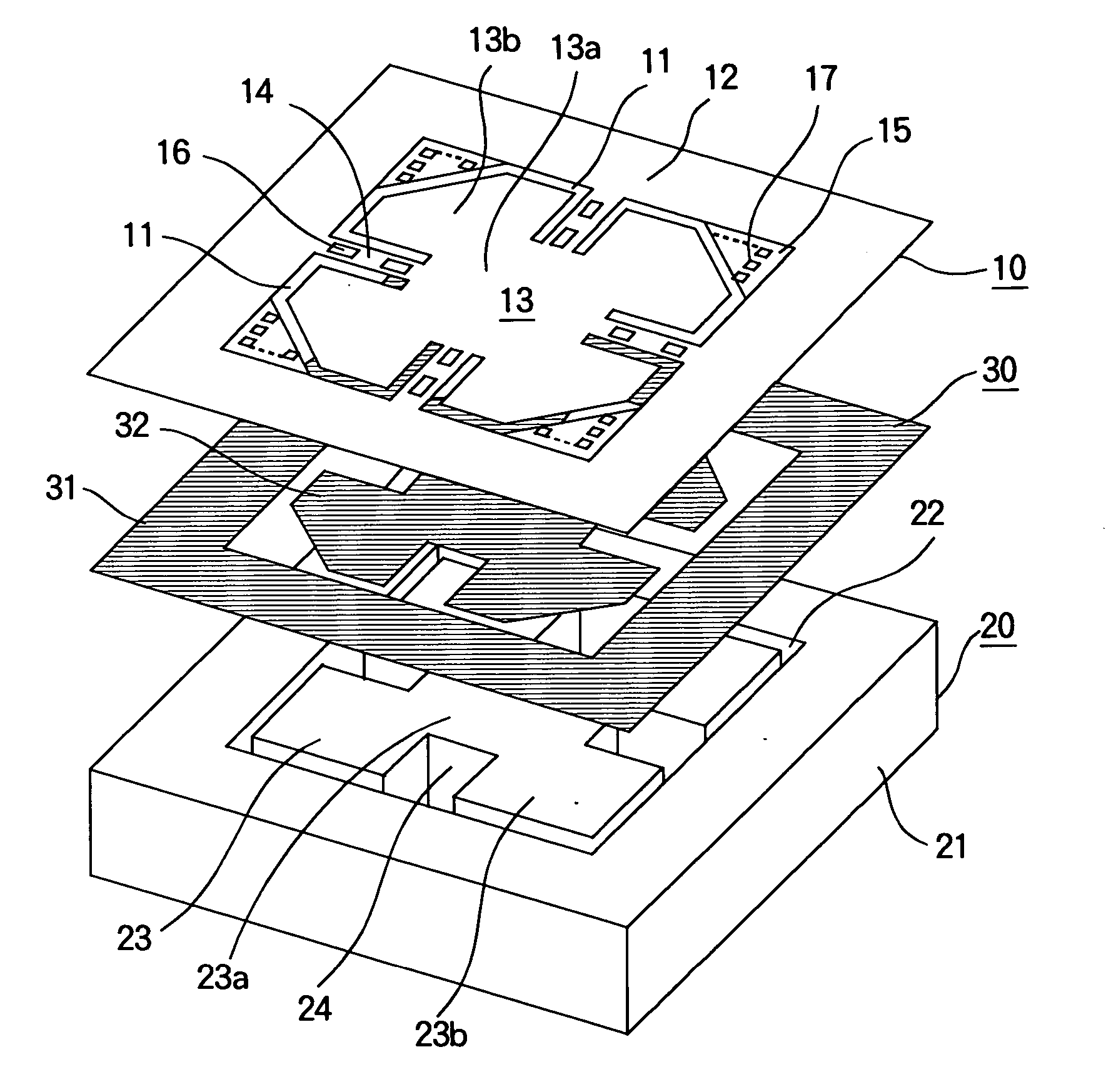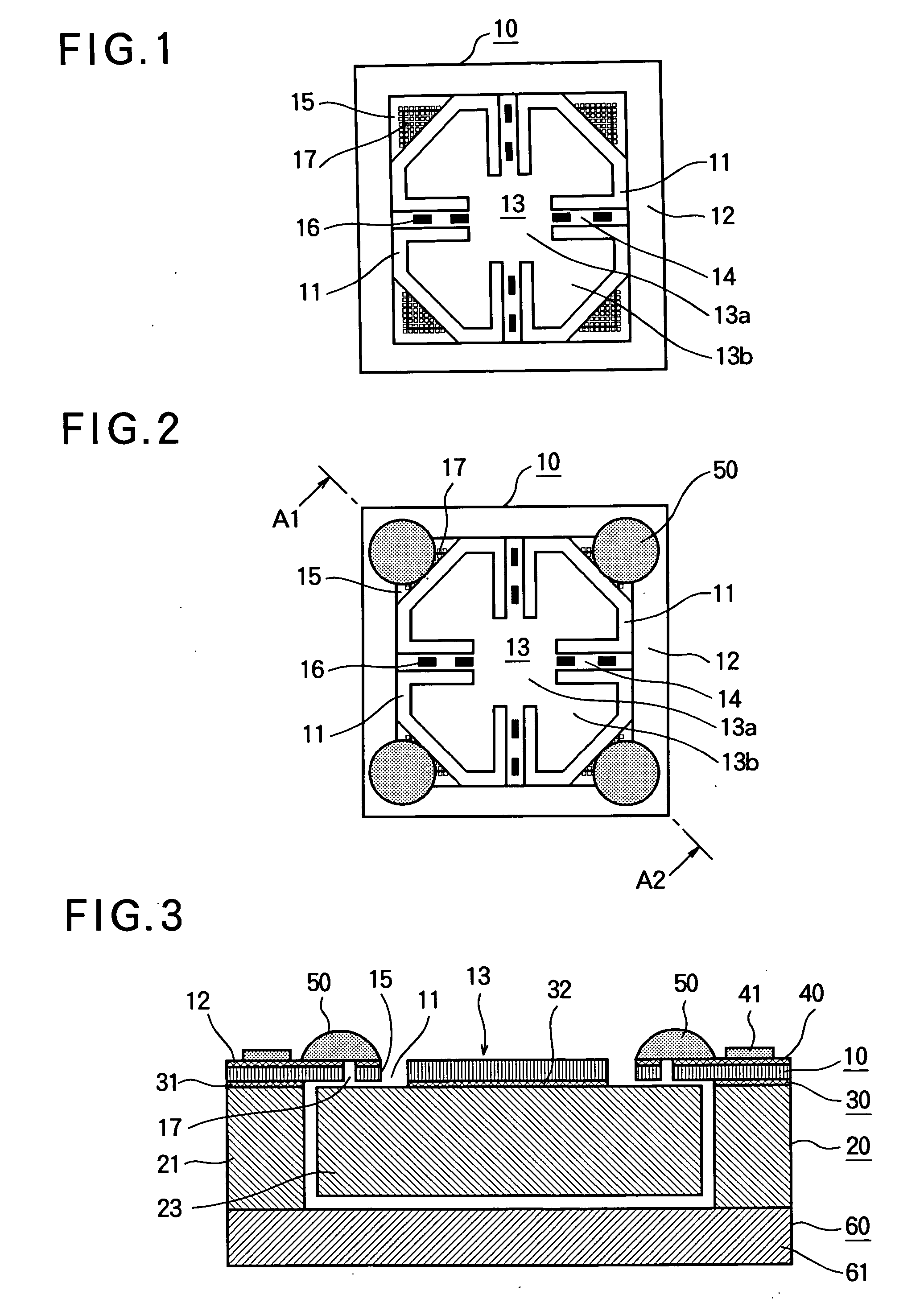Acceleration sensor manufactureable by simplified method
a manufacturing method and acceleration sensor technology, applied in the direction of acceleration measurement in multiple dimensions, acceleration measurement using interia forces, instruments, etc., can solve the problems of inefficiency, high cost, and time-consuming deposition, and achieve the effect of simplifying the manufacture of acceleration sensors
- Summary
- Abstract
- Description
- Claims
- Application Information
AI Technical Summary
Benefits of technology
Problems solved by technology
Method used
Image
Examples
first embodiment
[0031] A first embodiment will be described with reference to the top plan views in FIGS. 1 and 2, the sectional view in FIG. 3, the perspective view in FIG. 4, and the bottom plan view in FIG. 5.
[0032] The first embodiment is an acceleration sensor formed in a silicon-on-insulator (SOI) wafer by etching and other processes. The SOI wafer includes a first silicon substrate 10 approximately ten micrometers (10 μm) thick, a second silicon substrate 20 approximately 525 μm thick, and an insulating bonding layer 30 by which the first silicon substrate 10 and second silicon substrate 20 are joined.
[0033] The first silicon substrate 10 of a single acceleration sensor has a substantially square shape measuring about two and a half millimeters (2.5 mm) on a side, in which four openings or trenches 11 are provided to define a peripheral attachment section 12, a mass attachment section 13, beams 14, and stoppers 15. The peripheral attachment section 12 is an area approximately 500 μm wide, ...
second embodiment
[0064] In a second embodiment, the silicone rubber reinforcement is applied as a plurality of drops (for example, three drops 50-1, 50-2, 50-3 as shown in FIG. 20) to each of the stoppers 15 from the dispenser 70. Otherwise, the structure and manufacturing method are the same as in the first embodiment.
[0065] In the first embodiment, since the silicone rubber 50 is applied as one drop, a height of, for example, 250 μm or more is required for adequate reinforcement, and the package 60 must be thick enough to accommodate this height. In the second embodiment, since the silicone rubber applied to each stopper 15 is dispensed from the dispenser 70 as a plurality of smaller drops 50-1 to 50-3, the heights of the drops can be reduced to as little as about 150 μm while still providing adequate reinforcement, so the thickness of the package 60 can be reduced. Impact resistance is also improved in that the reinforcement is spread over a wider area of the stoppers 15.
third embodiment
[0066] In a third embodiment, silicone rubber 50A is applied by the dispenser 70 as a swath covering at least part of all of the stoppers 15 and part of the adjacent surface of the peripheral attachment section 12 to reinforce the stoppers 15 and peripheral attachment section 12. As shown in FIG. 18, for example, if the dispenser 70 moves in a line along the peripheral attachment section 12, starting from one stopper 15 and ending at another stopper 15, the silicone rubber 50A can be applied as a single continuous swath. In this case, a uniform swath of silicone rubber 50A can be applied by lifting the dispenser 70 away from the peripheral attachment section 12 as the dispenser 70 retraces the final part of the swath, moving backward from the final application point.
[0067] In FIG. 21, since the silicone rubber 50A is not applied in a complete loop, there is a part of the peripheral attachment section 12 to which no silicone rubber is applied. Electrical interconnection terminals ca...
PUM
 Login to View More
Login to View More Abstract
Description
Claims
Application Information
 Login to View More
Login to View More - R&D
- Intellectual Property
- Life Sciences
- Materials
- Tech Scout
- Unparalleled Data Quality
- Higher Quality Content
- 60% Fewer Hallucinations
Browse by: Latest US Patents, China's latest patents, Technical Efficacy Thesaurus, Application Domain, Technology Topic, Popular Technical Reports.
© 2025 PatSnap. All rights reserved.Legal|Privacy policy|Modern Slavery Act Transparency Statement|Sitemap|About US| Contact US: help@patsnap.com



